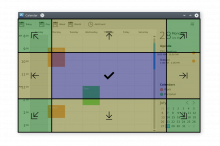Resizing windows with touch is cumbersome at the moment. It is difficult to hit the resize area (with or without borders) with a finger.
It would make sense to develop a distinct interaction pattern for touch resize, which might be completely different to how resize works with a more precise pointer event.
Any ideas or examples from other software?
